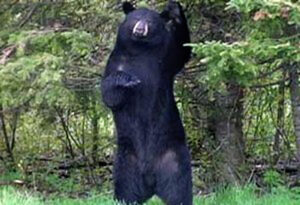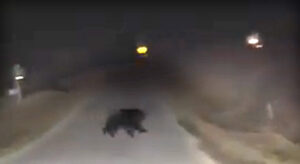THEY’RE BA-A-CK!
Hibernation Over, Bears On Prowl
By JIM KEVLIN • Special to www.AllOTSEGO.com

Vince Casale knew something was up when he saw an empty, broken bird feeder from the other side of the house in the middle of his driveway as he drove out, taking wife Lynne to a birthday dinner.
“I heard something rustling in the dry leaves outside the driveway,” he said. “It sounded big. I thought it had to be a deer.”
As they were leaving the Bed Bug Road neighborhood on Tuesday, March 23, heading toward Fly Creek, “we saw the bear exiting the road on the left side,” he said.
Lynne pulled out her camera, and captured the bear’s movements and it moved back off the left side of the road, then back across the road into a field on the right.
Get ready, Otsego County, we’re going to see a lot more of these sightings as black bears move north from the Catskills into the woods around here, said Josh Choquette, the wildlife technician in the state Department of Environmental Conservation’s Stamford Office who specializes in the bear population.
What happened to the Casales – “she’s a bird enthusiast, and had just filled the feeders,” said the husband – will happen more frequently to bird lovers, unless they take precautions, Choquette said.
“This is the time of year that black bears emerge from their dormancy,” he said.

Bears like skunk cabbage, found in wetlands and low wet areas. But, “the Number One food they are looking to forage is birdseed,” he said. “That presents an abundant and usually obtainable food source in Region 4.” (Otsego County, plus counties from Delaware to the Hudson River.)
“These bear are very curious, really intelligent. They know where these food sources are and where to find them,” he said. The DEC recommends that bird feeders be taken down April 1 and not put up again until Nov. 30.
Big males – “boars,” they’re called – are what you’ll see at this time of year; “some may be out all winter long.” The females have cubs, which are vulnerable, so they stay put and keep them close by.
For now, the Otsego County bear population is low, compared to Delaware and Green counties. “We average only 12 bear complaints a year from Otsego,” he said.
“But they’re starting to make that migrant push north, and starting to inundate these area,” he said. “Farms have gone out of business. Farmland is turning into habitat.
“I would say, in the next 10 years, it’s a safe bet you will see a lot more incidents occur in Otsego County,” Choquette said.
For his part, Casale said it’s rare to hear of bear sightings on the west side of Otsego Lake; most are in the Town of Middlefield.
But he’s aware that, when foraging, if bears can’t find bird feeders where they think they’ll be, “they try to break into your house or garage.
“We’re certainly being more vigilant,” he said.

